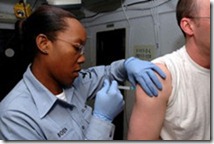The best way to prevent Hepatitis B is by getting vaccinated.
Credits: U.S. Navy photo by Photographer's Mate Airman Apprentice Christopher D. Blachly
February 19, 2012
Infectious Disease Examiner
The World Health Organization (WHO) reports that 60 percent of the Philippine’s population has been infected with HBV, while approximately 10 percent have chronic or active hepatitis B and are carriers.
According to Dr. Lemuel Delos Reyes, medical doctor and Hepatitis B Awareness Campaign advocate, “This means that there are already around eight to 10 million hepatitis B carriers in the country who might infect more people.”
To draw awareness on the hepatitis B issue in the Philippines, the Philippine Council for Health Research and Development of the Department of Science and Technology (PCHRD-DOST) conducted a seminar on “Code Yellow, Mission Against Hepatitis” to draw awareness on the dreadful disease.
In a report on the PCHRD-DOST web site Friday, Dr. Gerald Belimac, program manager of the Department of Health’s National AIDS STI Prevention and Control Program said, “Hepatitis B is 100 times more contagious than the AIDS virus. It is also the most common cause of liver infection leading to liver cancer - the principal cause of cancer death in many parts of Africa, Asia and the Pacific Region.”
According to the US CDC, Hepatitis B is a contagious liver disease that results from infection with the Hepatitis B virus. It can range in severity from a mild illness lasting a few weeks to a serious, lifelong illness. Hepatitis B is usually spread when blood, semen, or another body fluid from a person infected with the Hepatitis B virus enters the body of someone who is not infected. This can happen through sexual contact with an infected person or sharing needles, syringes, or other drug-injection equipment. Hepatitis B can also be passed from an infected mother to her baby at birth.
Hepatitis B can be either acute or chronic. Acute Hepatitis B virus infection is a short-term illness that occurs within the first 6 months after someone is exposed to the Hepatitis B virus. Acute infection can — but does not always — lead to chronic infection. Chronic Hepatitis B virus infection is a long-term illness that occurs when the Hepatitis B virus remains in a person’s body. Chronic Hepatitis B is a serious disease that can result in long-term health problems, and even death.
Although there is no cure for hepatitis B it is a preventable disease. The best way to prevent Hepatitis B is by getting vaccinated.
Dr Delos Reyes said, “Vaccination is the easiest and most logical means of preventing the disease. It is also recognized as the most effective and long term means of preventing hepatitis.”
The PCHRD-DOST conducted the seminar “Code Yellow, Mission Against Hepatitis” Jan 30.

No comments:
Post a Comment